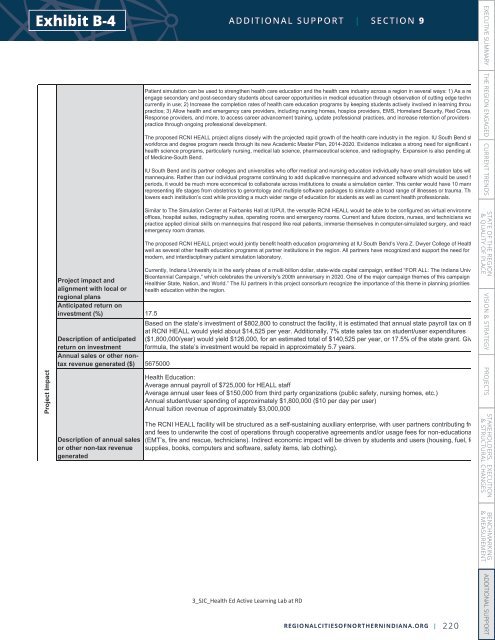INNOVATE INDIANA
d0s2Sh
d0s2Sh
- No tags were found...
Create successful ePaper yourself
Turn your PDF publications into a flip-book with our unique Google optimized e-Paper software.
Exhibit B-4<br />
ADDITIONAL SUPPORT | SECTION 19<br />
Patient simulation can be used to strengthen health care education and the health care industry across a region in several ways: 1) As a recruiting too<br />
engage secondary and post-secondary students about career opportunities in medical education through observation of cutting edge technologies<br />
currently in use; 2) Increase the completion rates of health care education programs by keeping students actively involved in learning through applied<br />
practice; 3) Allow health and emergency care providers, including nursing homes, hospice providers, EMS, Homeland Security, Red Cross, FEMA Ra<br />
Response providers, and more, to access career advancement training, update professional practices, and increase retention of providers currently in<br />
practice through ongoing professional development.<br />
The proposed RCNI HEALL project aligns closely with the projected rapid growth of the health care industry in the region. IU South Bend studied regi<br />
workforce and degree program needs through its new Academic Master Plan, 2014-2020. Evidence indicates a strong need for significant expansion<br />
health science programs, particularly nursing, medical lab science, pharmaceutical science, and radiography. Expansion is also pending at the IU Sch<br />
of Medicine-South Bend.<br />
IU South Bend and its partner colleges and universities who offer medical and nursing education individually have small simulation labs with 1-3<br />
mannequins. Rather than our individual programs continuing to add duplicative mannequins and advanced software which would be used for limited t<br />
periods, it would be much more economical to collaborate across institutions to create a simulation center. This center would have 10 mannequins<br />
representing life stages from obstetrics to gerontology and multiple software packages to simulate a broad range of illnesses or trauma. Thus, collabo<br />
lowers each institution’s cost while providing a much wider range of education for students as well as current health professionals.<br />
EXECUTIVE SUMMARY THE REGION ENGAGED CURRENT TRENDS<br />
Project Impact<br />
Project impact and<br />
alignment with local or<br />
regional plans<br />
Similar to The Simulation Center at Fairbanks Hall at IUPUI, the versatile RCNI HEALL would be able to be configured as virtual environments for me<br />
offices, hospital suites, radiography suites, operating rooms and emergency rooms. Current and future doctors, nurses, and technicians would be able<br />
practice applied clinical skills on mannequins that respond like real patients, immerse themselves in computer-simulated surgery, and react to complic<br />
emergency room dramas.<br />
The proposed RCNI HEALL project would jointly benefit health education programming at IU South Bend’s Vera Z. Dwyer College of Health Sciences<br />
well as several other health education programs at partner institutions in the region. All partners have recognized and support the need for a central,<br />
modern, and interdisciplinary patient simulation laboratory.<br />
Currently, Indiana University is in the early phase of a multi-billion dollar, state-wide capital campaign, entitled “FOR ALL: The Indiana University<br />
Bicentennial Campaign,” which celebrates the university’s 200th anniversary in 2020. One of the major campaign themes of this campaign is “Creatin<br />
Healthier State, Nation, and World.” The IU partners in this project consortium recognize the importance of this theme in planning priorities for growth<br />
health education within the region.<br />
Anticipated return on<br />
investment (%) 17.5<br />
Based on the state’s investment of $802,800 to construct the facility, it is estimated that annual state payroll tax on the direct<br />
at RCNI HEALL would yield about $14,525 per year. Additionally, 7% state sales tax on student/user expenditures<br />
Description of anticipated ($1,800,000/year) would yield $126,000, for an estimated total of $140,525 per year, or 17.5% of the state grant. Given this<br />
return on investment formula, the state’s investment would be repaid in approximately 5.7 years.<br />
Annual sales or other nontax<br />
revenue generated ($) 5675000<br />
Description of annual sales<br />
or other non-tax revenue<br />
generated<br />
Health Education:<br />
Average annual payroll of $725,000 for HEALL staff<br />
Average annual user fees of $150,000 from third party organizations (public safety, nursing homes, etc.)<br />
Annual student/user spending of approximately $1,800,000 ($10 per day per user)<br />
Annual tuition revenue of approximately $3,000,000<br />
The RCNI HEALL facility will be structured as a self-sustaining auxiliary enterprise, with user partners contributing from tuition<br />
and fees to underwrite the cost of operations through cooperative agreements and/or usage fees for non-educational partner<br />
(EMT’s, fire and rescue, technicians). Indirect economic impact will be driven by students and users (housing, fuel, food,<br />
supplies, books, computers and software, safety items, lab clothing).<br />
STATE OF THE REGION<br />
& QUALITY OF PLACE<br />
VISION & STRATEGY PROJECTS<br />
STAKEHOLDERS, EXECUTION<br />
& STRUCTURAL CHANGES<br />
BENCHMARKING<br />
& MEASUREMENT<br />
3_SJC_Health Ed Active Learning Lab at RD<br />
REGIONALCITIESOFNORTHERN<strong>INDIANA</strong>.ORG |<br />
220<br />
ADDITIONAL SUPPORT


